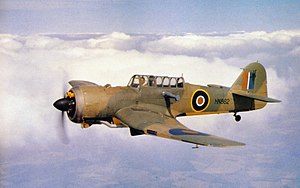| M.25 Martinet | |
|---|---|
| Role | Target tug |
| Manufacturer | Miles Aircraft |
| First flight | 24 April 1942 |
| Primary users | Royal Air Force Fleet Air Arm |
| Produced | 1942-1945 |
| Number built | 1,724 |
The Miles M.25 Martinet was a target tug aircraft of the Royal Air Force and Fleet Air Arm that was in service during the Second World War. It was the first British aircraft to be designed specifically for the role of towing targets.
Design and development[]
Based upon the Miles Master II, the Martinet featured a strengthened airframe to handle the stresses of towing a target drogue. Other differences from the Master included a longer nose, higher cockpit and greater wing span but otherwise the two aircraft shared many common components. The targets and towing gear were contained in a fairing beneath the fuselage and were retracted by an external, wind-powered winch.
The first prototype Martinet was first flown on 24 April 1942 by Chief Test Pilot F/Lt Thomas Rose from Woodley Aerodrome. In total, 1,724 Martinets were produced by Miles Aircraft Ltd for the RAF and FAA to meet Air Ministry Specification 12/41. There were two other variants of the Martinet. The M.50 Queen Martinet was a radio-controlled target drone of which 69 were built and a further 17 produced through conversion of production Martinets. The M.37 Martinet Trainer was developed during the war but only two were ever produced. All Martinets and their variants were manufactured at Woodley.
Variants[]
- M.25 Martinet: Two-seat target tug aircraft. The M.25 Martinet was used by both the RAF and the Royal Navy, under the designation Martinet TT.Mk I.
- M.50 Queen Martinet: Unmanned radio-controlled target drone.
- M.37 Martinet Trainer: Two-seat training aircraft. Only two were built.
Operators[]

Martinet in RAF service
- Belgian Air Force (11 operated from 1947 to 1953 as target tugs)
Specifications (M.25)[]

Data from The Hamlyn Concise Guide to British Aircraft of World War II.[1]
General characteristics
- Crew: two
- Length: 30 ft 11 in (9.42 m)
- Wingspan: 39 ft (11.89 m)
- Height: 11 ft 7 in (3.53 m)
- Wing area: 242 ft² (22.48 m²)
- Empty weight: 4,600 lb (2,090 kg)
- Loaded weight: 6,680 lb (3,030 kg)
- Max. takeoff weight: 6,750 lb (3,062 kg)
- Powerplant: 1 × Bristol Mercury 20 or 30 radial engine, 870 hp (649 kW)
Performance
- Maximum speed: 240 mph (386 km/h) at 15,000 ft (4,600 m)
- Cruise speed: 199 mph at 5,000 ft (320 km/h at 1,525 m)
- Range: 694 miles (1,117 km)
- Wing loading: 28.1 lb/ft² (137.1 kg/m²)
- Power/mass: 0.235 hp/lb (0.389 kW/kg)
Surviving aircraft[]
A single Martinet survives; it is owned by the Museum of Berkshire Aviation in the United Kingdom. The aircraft (RAF serial number MS902) was built in 1943, and spent its operational life in Iceland at RAF Reykjavik. In 1949, MS902 was sold to the Akureyri Flying Club and given the Icelandic civil registration TF-SHC. The club flew it until it crashed in 1951 near Kopasker in northeast Iceland. The wreckage remained at the crash site until 1977, when it was recovered and placed in storage by the Icelandic Aviation Historical Society. The aircraft was returned to the United Kingdom in 1996 by the Museum of Berkshire Aviation and has since been the subject of a lengthy restoration project.[2][3]
See also[]
References[]
Notes[]
- ↑ Mondey 1994, p. 171.
- ↑ "Miles M.25 Martinet TT.1." The Museum of Berkshire Aviation. Retrieved: 11 May 2013.
- ↑ "title=Martinet Restoration News." The Museum of Berkshire Aviation. Retrieved: 11 May 2013.
Bibliography[]
- Amos, Peter. Miles Aircraft - The Wartime Years, 1939 to 1945. Tonbridge, Kent, UK: Air-Britain (Historians) Ltd, 2012. ISBN 978-0-85130-430-4.
- Amos, Peter and Don Lambert Brown. Miles Aircraft Since 1925, Volume 1. London: Putnam Aeronautical, 2000. ISBN 0-85177-787-2.
- Brown, Don Lambert. Miles Aircraft Since 1925. London: Putnam & Company Ltd., 1970. ISBN 0-370-00127-3.
- Mondey, David. The Hamlyn Concise Guide to British Aircraft of World War II. London: Chancellor Press, 1994. ISBN 1-85152-668-4.
External links[]
| Wikimedia Commons has media related to Miles M.25 Martinet. |
The original article can be found at Miles Martinet and the edit history here.
